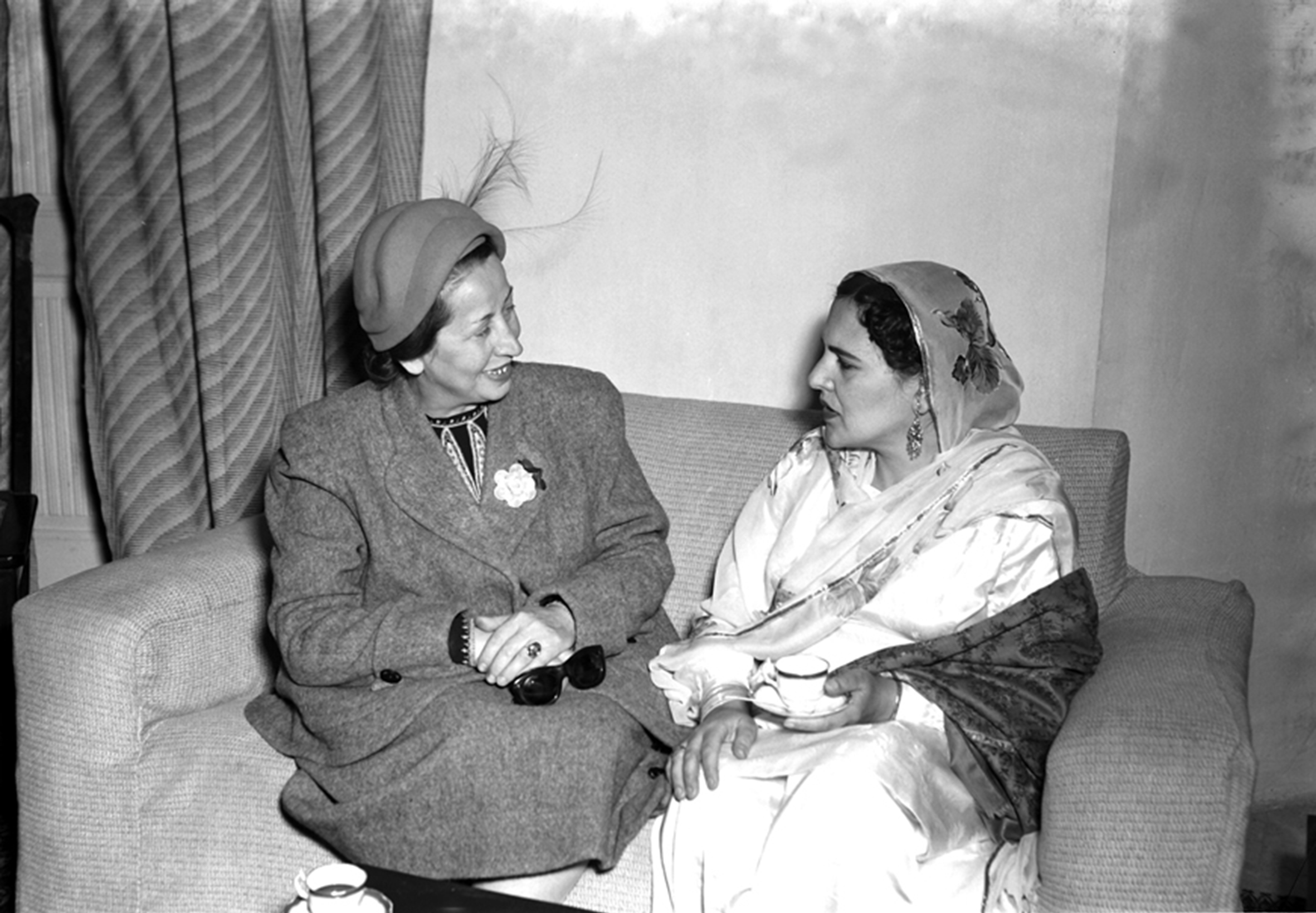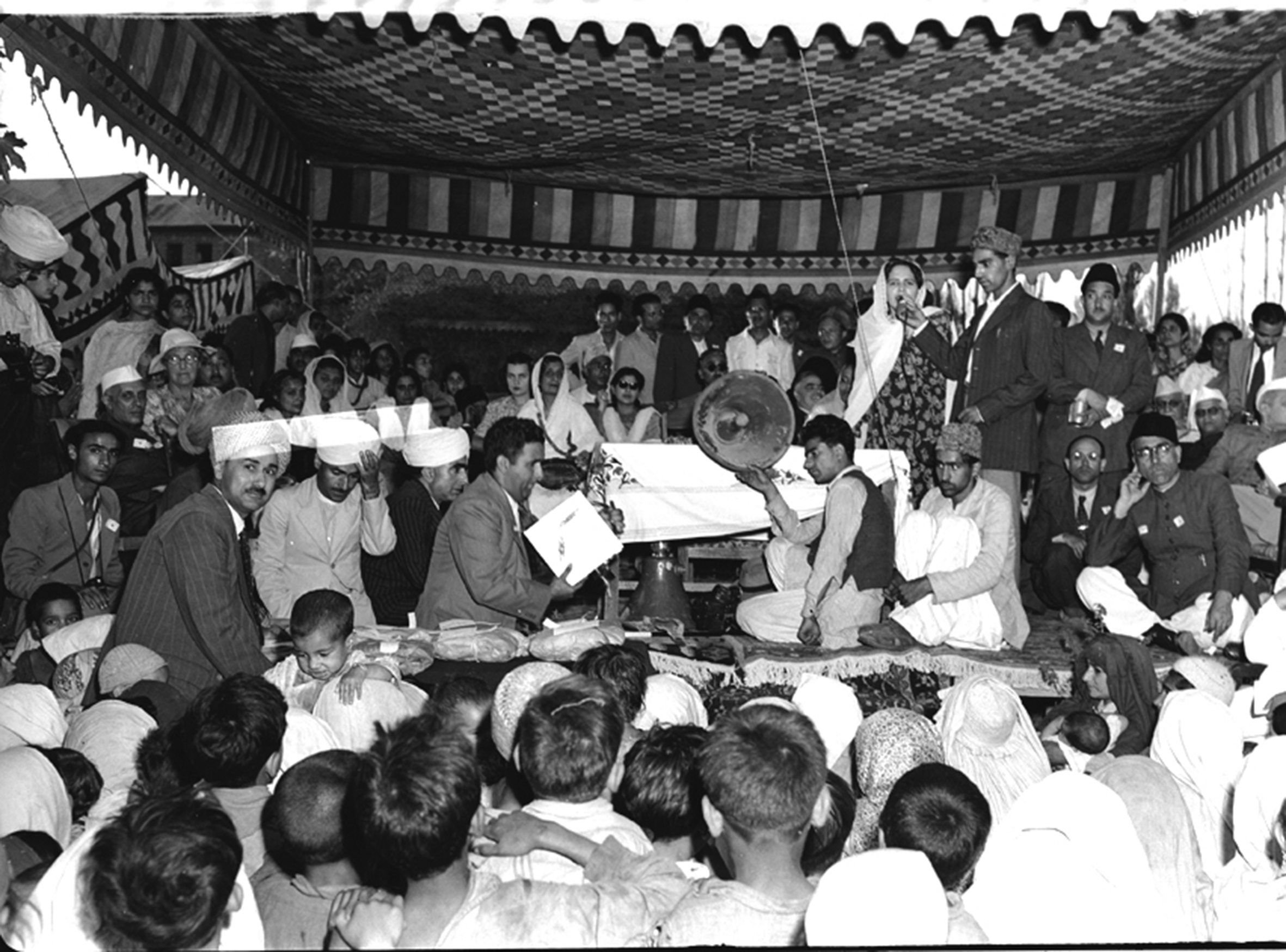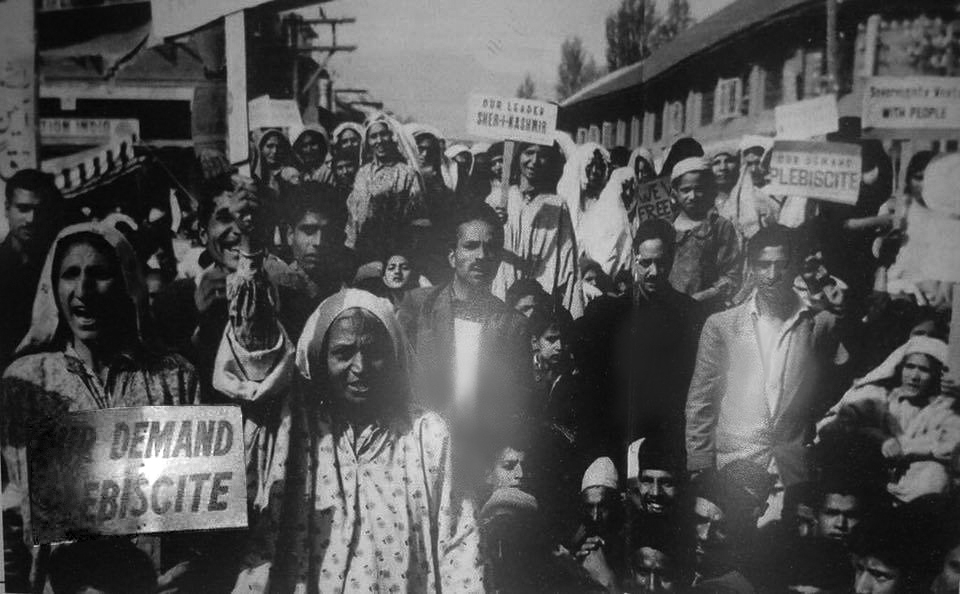After centuries of suppression when Kashmir launched its struggle to regain the life of dignity and honour, it was not a male-only battle. Dr Shazia Malik traces the roots of women participation in the Kashmir politics starting 1931

Begum Sheikh Abdullah interacting with Adviye Fenik, a senior member of Turkish media delegation that visited Kashmir in March11-19, 1952
The women of Kashmir played a conspicuous role in the struggle against the Dogra rule.
In a meeting at Khanqa-he-Maula, one Abdul Qadeer, a non-Kashmiri Muslim who was in Srinagar came on the stage and said “we do not have guns, but we have plenty of stones and brickbats.” (see Khan, G H, Freedom Movement in Kashmir, page 130) On June 25, 1931 he was arrested. The trial of Abdul Qadeer started on July 6, 1931 at Session’s High court, Srinagar. On July 13, 1931, the judgment was pronounced at the central jail, Srinagar. According to an estimate a mob of four to five thousand people had gone to witness the trial. They shouted the slogans Allaho-Akbar, Qadeer Zindabaad and in a short while the police started firing the protestors, killing a large number among them.
Remarkably, the women of the working classes of the Muslim society fought shoulder to shoulder with their counterpart against the injustice and misrule of the Dogra despots. Clearly, then during its first phase of the freedom struggle, the women participants came from the lower sections of society, illiterate and uneducated. These women of the lower orders were not led and organized by educated women but it was their movement that educated women joined later in the period. (Mohammed Yasin and Madhvi Yasin (ed.), Mysteries and Glimpses of Kashmir, p 197-198)
With the imposition of martial law, a reign of terror was let loose in Srinagar. The Kashmiris were forced to kiss the Dogra flag and lick the shoes of the soldiers and salute every soldier with the Dogra salutation, “Jai Dev Maharaj”. Hand written revolutionary posters appeared in Srinagar after the arrest of Sheikh Mohammed Abdullah. During this period women processionists, many of them with suckling babies in their arms, passed through the streets raising slogans against the oppressive Dogra regime and demanding the release of their imprisoned leaders and for the establishment of a democracy in Kashmir. The protesting women were surrounded by the armed police and were ordered to disperse. On their refusal, they were abused, molested, and then killed in large numbers by the agents of the state. Their bodies were recovered from the river in the Srinagar, where they have been dumped by the police.
Women came out in procession on July 27 again, carrying black flags. In 1931 when the government handed over the military administration to the command on September 6, a crowd of women agitators was lathi charged and their modesty outraged; 10 women received injuries.
Addressing the procession on 2nd August 1931, a Kashmiri women speaker said:
“Our men should sit in their homes and wear Burqas! We are proud of our Punjabi Muslim brethren but so far they have confined themselves to merely issuing statements. We request the members of British parliament to take our grievances to the League of Nations. We appeal to the army not to oppress women as it was no chivalry. But if they have any such instructions, they will find us ready to meet the challenge.”
(Saraf Muhammed Yusuf, Kashmiris Fight- For Freedom Vol 1-1819-1946)

The government organised a baby show on September 25, 1949 to provide entertainment to the delegates who were in Srinagar to attend annual session of NC. While a woman is making a speech, those listening include Pandit Nehru, Rajkumari Amrit Kaur NV Gadgil and Sheikh Muhammad Abdullah
In response to an appeal issued by the All India Kashmir Committee, Kashmir Day was observed all over the state on August 14, 1931. Its aim was to bring pressure upon the government of India to help the Kashmiris secure the basic rights denied to them. A complete hartal was observed and processions were taken out. Meetings were held at Mazar-e-shohada which were attended by about thirty thousand women. It was addressed by Sheikh Mohammed Abdullah, Chaudhri Ghulam Abbas Khan and Mistri Yaqub Ali.
It was followed by another mass meeting at Jamia Masjid. At the end of the meeting, the blood-stained clothes of the martyrs were displaced to the audience. (Saraf, p397) The Muslims of Delhi celebrated the Kashmir day for two consecutive days (Khan p 139). September 24, 1931 saw the first armed resistance of the Kashmiri Muslims against the excesses of the government when Srinagar was pasted with notices suggesting “Mohammedans have no quarrel with the Hindus but have declared Jihad against his highness government.” (Telegram from resident in Kashmir No. 60-c dated sep 24 931, file no. 423(2) of 1931 home/political secret) Armed with axes, spades, hoes, scythes, pick-axes, knives, harpoons, swords and sticks, about fifteen thousand people had assembled by 1pm (Khan p 155).
One of the heroines of 1931 upheaval Fazli died on September 24, 1931, when the military opened fire on a procession of women parading through the Maisuma bazaar Srinagar. In Shopian, Sajida Bano, aged 25 years, who had recently lost her husband, received a bullet wound in military firing, she was pregnant and died along with the child on the spot. (Madhvi Yasin in Mohd Yasin and Qayum Yasin(ed.) History of the Freedom Struggle in J&K)
Jan begum, widow of Abel Lone, Srinagar, was killed in a police firing.
These women, illiterate and socially inferior, anticipated the movement led by the educated women in the later phase of the freedom struggle.
Another heroine of the upheaval was Jan Ded. Jan Ded was illiterate and came from the lower sections in society and this is why her sacrifice has been ignored in the discourse of the freedom struggle in Kashmir. Her natural talents were not exploited, even though she fought well against the injustices. She was pragmatist and was poles apart from many of the male political leaders of Kashmir in that she advocated secularism and shunned narrow communal loyalties. She was ebullient, outspoken and demanding. She incurred wrath of the top Muslim leaders, and had to retire from the active politics after 1934. (Madhvi)
A memorandum was presented to the Maharaja, which said:
“Some constables of the training school who were coming towards the city in a lorry, attacked innocent and peaceful Muslim passersby inflicting death on some and injuries on some others…..with promulgation of martial law, army wrought havoc on the Muslim passers-by were murdered; peaceful citizens were forcibly brought out of their homes and tortured and arrested: nothing was left undone to disgrace, dishonor and destroy Muslim homes : women were assaulted and outraged: …………..wherever it was possible poor men and women were either drowned or strangulated.” (Saraf p 399)
On September 22, people again collected in the Jamia Masjid and came out in a procession. The army fired several rounds and three protestors were killed on the spot and more than a dozen injured. On the same day the military also opened fire on another procession at Maisuma which included women, killing two men and wounding three, including a woman. (Saraf p 403) Processions of women were a common feature of the agitation in various localities of Srinagar and the towns of Baramulla, Sopore, Islamabad (Anantnag) and Shopian. It goes to the credit of the daughters of the valley that although illiterate and unaware of their rights and traditionally confined to their homes, they braved hardships smilingly and fought shoulder to shoulder with men folk for the emancipation of their country from Dogra rule. (Saraf p 404)
On August 18, a Muslim women carrying vegetables for sale was way laid by Pandit boys near Khankah-e-Sokhta. Her clothes were torn and she was left almost naked. Soon a dead body of a Muslim Women was recovered from a river she was allegedly drowned by soldiers presumably after rape. (Saraf p 414)

Hamla Awar Khabardaar: Womens Defence Corps in Kashmir, a 1947 photograph
On January 28, 1932 a number of women took out a procession. When they reached near the right bank of Jhelum, in the midst of the town, the police blocked their passage and the sub-inspector used abusive language against political leaders. Begum Bohru, a widow from Baramulla was carrying a Kangri (firepot) filled with burning charcoal. She hurled it at the sub-inspector. It crashed straight into his face which was permanently disfigured – the gallant woman was shot dead on the spot. (Saraf 436-37)
One Noor Gujri, a milkman’s daughter, plagued the military and police though her vituperative utterance and pugnacious pranks. She was repeatedly arrested, clamped in prison for a few days and released. The National leaders boosted her and denounced the authorities for imprisoning her. (Bazaz P N, Daughters of Vitasta, p 262).
In 1939, the Muslim conference was transformed into National Conference…The annual session of the party was held in Srinagar on September 25-30, 1944 in Pather Masjid. The session is important as it adopted a political economic and social programme for Kashmir, the Naya Kashmir. The historic new Kashmir manifesto granted women the right to vote and contest elections. Women were guaranteed equal rights with men in all fields of national life; political, economic, cultural as also in the state services.
Sheikh Abdullah launched the Quit Kashmir movement with a highly anti government speech at Srinagar on May 15, 1946. Muslim women not only took out processions in defiance of prohibitory orders but also participated in large numbers in the public meetings held at Khanqahe-Maula and Hazratbal. The women of Kashmir from all walks of life came forward with redoubled enthusiasm and energy in support of their beloved leader. (Saraf p 676).
One Zoni Gujri was put behind bars as many as nine times. Several times she was attacked by the armed police. She was at that time in her teens, and her husband was dead against her political activities. Wife of a poor working man, politics was no luxury for her; home was to be looked after. Her magnetic oratory drew large throngs of women agitators. Gujri lost her only son aged 12 years when a bullet struck the boy in an assault made by the military police.
Another woman, Fatima a peasant woman was shot dead at Islamabad by the Dogra forces in May 1946, while leading a procession to Voice against the repressive policy of the Maharaja. The Dogra forces had occupied the town and armed soldiers were parading through the streets with pointed bayonets fixed on their guns. Some people took a procession in defiance to the military orders. Fatima, also joined at the head of the women processionists and was attacked by the armed soldiers. (Madhvi, p 204-206)
Begum Zainab discarded purdah and led anti government demonstrations and delivered speeches to the NC workers. Collecting donations from charitable sympathizers, she arranged relief for victims of Dogra aggression. Bazaz p 269) Begum Akbar Jahan, wife of Abdullah threw herself in the freedom struggle after Sheikh Abdullah and his colleagues were arrested during Quit Kashmir movement. She led anti-government demonstrations and kept the morals of the freedom fighters alive. She not only fought against the Dogra oppression but also collected donations from the people for the victims of the Dogra persecution. In February 1947 the cost of living registered an alarming increase in the state. NC set up a food committee with Begum Abdullah as chairwomen distributing food on subsidized cost. She started a mass campaign against the rising cost of living. (Bazaz, p 687)

Kashmiri women spearheading a rally demanding plebiscite
In 1947, India and Pakistan had come into existence. Sheikh Abdullah was released in September 1947, but he refused to accept the two nation theory… NC firmly placed its bet on India, and supported the accession of Kashmir to India. It asked people to collectively donate their weapons and their vehicles.
This was the beginning of the people’s militia of Kashmir. Girls also joined the militia. (Sheikh Abdullah, Flames of Chinar p 94). Zoni Gujjari, joined Women’s Defence force and received militia training at a place, where now stands the New Secretariat building. During this period she vigorously struggled to topple the Dogra regime, and to have a democracy in Kashmir. She was awarded with title Zoni Mujahid in grateful acknowledgement for her Services. (Madhvi, p 201) Under the leadership of Sheikh Mohammed Abdullah National Militia and women’s Defense corps – volunteer forces of men and women, were organized to ward off the onslaught by the tribal raiders. With its multifaceted and radical activities, women’s self Defence corps (WSDC) was harbinger of social change. Attired in traditional Kashmiri clothes and carrying a gun around her shoulders, Zoni Gujri symbolized the WDSC. (Khan Nyla Ali, Islam, Women and Violence, p 116)
Ms Mehmooda Ahamd Ali Shah, a pioneering educationist and champion of women’s empowerment, along with other leader women, was also in the forefront of WSDC. During her student days in Lahore she joined the Punjab Students Federation, which was fighting against the British imperialism. In Kashmir she founded Free Thinkers Society which gathered under it the intellectuals of the state. She did great service in bringing normalcy to the state, when the sub-continent gripped in communal frenzy. Begum Zainab was a grass root level leader. She fought against the Dogra rule under the auspices of the NC. She took charge of the political dimensions of WSDC and shouldering a gun she was in the forefront, leading women’s contingents.
Sajida Zameer Ahmad was also associated with the Quit Kashmir Movement in its later stage. She joined the WSDC in 1947 and worked actively in various refugee camps.
(The essay is an edited part from a long chapter from Women’s Development Amid Conflicts in Kashmir: A Socio-Cultural Study Paperback, the 2014 book that author published. The book is mainly the research of her PhD from AMU.)















